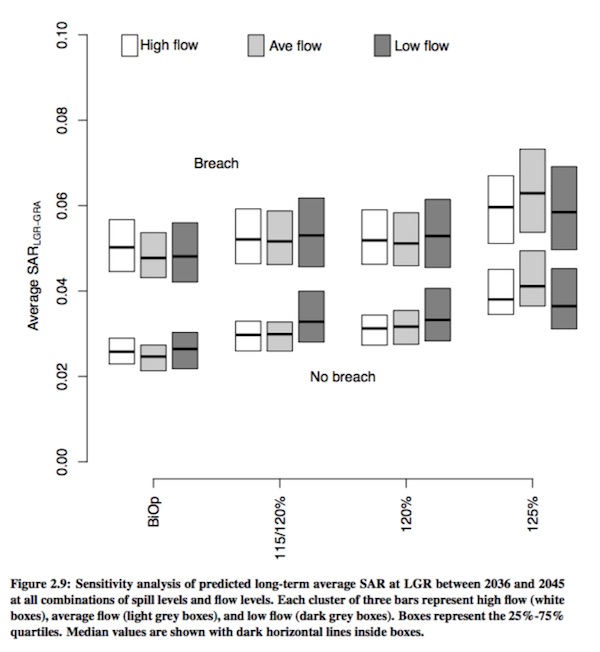forum
library
tutorial
contact

Court's Latest Spill Order: Massive Misuse of
People's Dollars and No Help to Salmon
by Terry Flores
Current Reflections Blog, January 22, 2018
|
the film forum library tutorial contact |

|
Court's Latest Spill Order: Massive Misuse of
by Terry Flores
|
 Most folks don't know what spill is -- and why should they?
Most folks don't know what spill is -- and why should they?
Because spill -- the water "spilled" through massive gates raised at federal hydropower dams in the Northwest -- hits all of us right in our wallets, through our electric bills.
The federal hydro projects on the Columbia and Snake rivers already spill 30 to 40 percent of the water in those rivers, which together drain a land area as large as France. Literally billions of gallons of water are spilled over the dams instead of generating more carbon-free energy that could help power our economy, keep electric rates low and our skies clean, and back up less-constant energy sources, like wind and solar.
Why we spill
The water spilled at the dams helps young salmon migrate more quickly and easily downstream, from the rivers to the ocean. If spill helps salmon, then a lot more spill should help a lot more salmon. Right?
Unfortunately, it's not that simple. But that's what the so-called fish advocates argued in the latest chapter of their 20-year litigation campaign against the federal dams and agencies. Persuaded by their arguments, U.S. District Court Judge Michael Simon this month approved an experimental plan that requires spilling additional water at each of the eight large federal projects -- all the way to the maximum level allowed under state water-quality laws, from April through mid-June.
Models show little impact
Here's the rub: There is no proof that more spill will be better for fish. In fact, modeling by NOAA Fisheries shows that more spill will have little to no impact on fish survival.
Estimates project an increase in survival rates of 1 percent for Chinook and 2 percent for steelhead. That's less than decimal dust in a complex river system where survival of young salmon migrating downstream varies year-to-year from 35 to 70 percent -- due to a range of potential factors unrelated to spill, including water temperatures, spring runoff timing and volumes, fish health, sea lions and other predators. The models show an even smaller impact on adult salmon returns of 1/100th percent.
The pro-spill groups claim that their modeling tells a different story, but they have yet to provide data that would allow for a full and accurate comparison of results.
Massive misuse of customers' money
Spill costs money, and the ones who pay are Northwest families and businesses. Spill costs are wrapped into the fish and wildlife costs that make up a major part of every residential or commercial electric bill.
More spill will cost more money -- an estimated $40 million more per year, according to Bonneville Power Administration -- which is poised to implement a "spill surcharge" on the power it sells from the dams to Northwest utilities and their customers. Regardless of the final total, electric bills will likely go up. This is a massive misuse of people's hard-earned dollars that will do little to nothing to help endangered salmon.
The new spill costs come on top of a 5 percent rate hike this year, and rate increases totaling nearly 30 percent over the last several years. One of the Northwest's prime economic advantages has been its traditionally low-cost electricity. But repeated rate increases are eroding that competitive advantage and BPA's historic position as one of the region's lowest-cost energy providers.
More spill may harm fish -- and the environment
Over and above the financial case is the harm that more spill may pose to the very fish that spill proponents say they want to protect. Too much spill produces dangerous levels of gas in the river, which can give young fish "the bends" similar to divers who rise up from deep seas too quickly. Churning waters at the dams from spill also prevents returning adult salmon from ascending the dams' ladders to reach their home rivers, where they spawn.
What's more, BPA estimates that the increased spill will result in another 840,000 tons of carbon added to Northwest skies--because carbon-emitting natural gas is likely to replace the carbon-free hydropower that will be lost to spill. That's a 1.7% increase in Northwest electricity sector emissions, at a time when state legislatures are grappling with proposals to reduce carbon emissions.
Judge Simon approved the experimental spill plan on January 8, declaring the science in this area "settled." Obviously, it isn't. The federal agencies agreed to the proposal "under protest," but are appealing the order, along with RiverPartners, tribes, Idaho and Montana, to the Ninth Circuit Court of Appeals.
Based on the NOAA models, we already know how this latest court-approved spill order is likely to turn out. It's a bad plan that will cost families and businesses, do little to help and may even harm protected salmon, and add tons of carbon to our air. It only makes sense if you want to increase the costs of operating the hydro dams because your true aim is their removal, which happens to be the goal of many of the so-called fish advocates.
We can all agree that the Northwest cares about our region's iconic salmon. But we shouldn't throw good money at a bad plan.
Related Pages:
Under Threat, BPA Maps Out Survival Strategy by Pete Danko, Portland Business Journal, 3/1/18
Removing LSR Dams a Colossal Breach of Logic, by Terry Flores, The Register-Guard, 12/11/6
learn more on topics covered in the film
see the video
read the script
learn the songs
discussion forum
